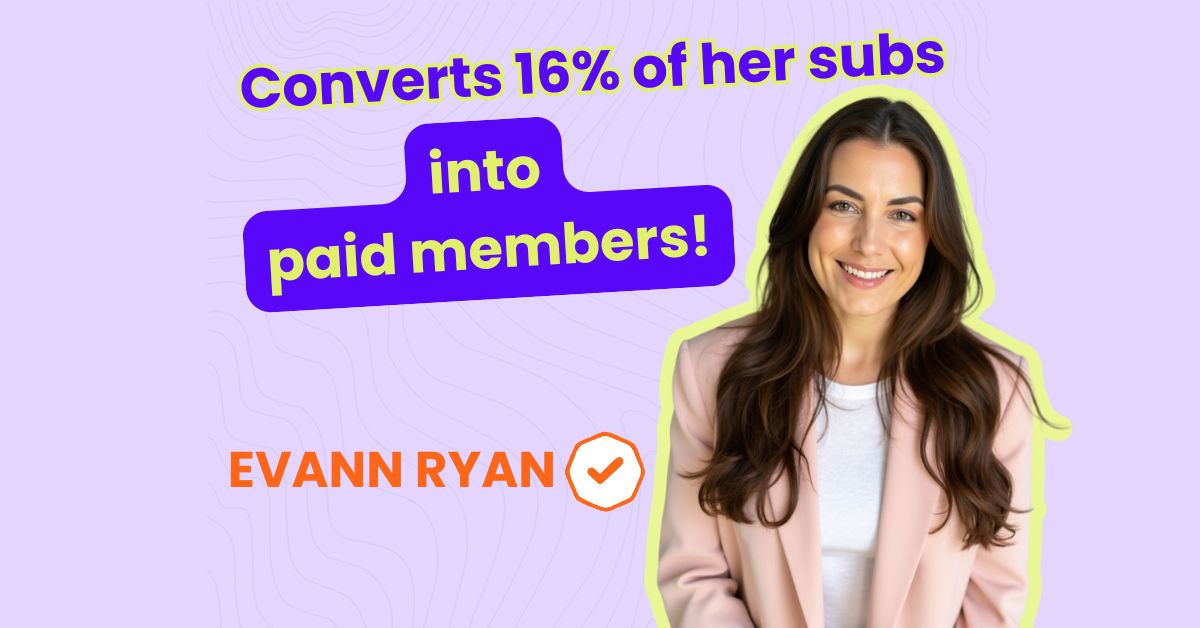Interview Publish Date: Oct 25, 2024
Table of Content
- Meet Nika Talbot
- Newsletter Identity Card
- Tool stack
- How she started her newsletter
- Most effective growth strategies she currently uses
- Biggest learnings when applying for a paid subscription
- Personal & professional impact of running a newsletter
- If she had a chance to start over
- Biggest advice to newsletter creators
MEET THE CREATOR
Nika Talbot. She is a writer, journalist and a book author.
She has been running her own business where she offers different services such as copywriting and newsletter management for over 15 years.
In parallel, she has been writing her own newsletter The Shift, since 2020 which is a business and creativity newsletter with stories and strategies for entrepreneurial writers.
She is a jack of all trades and a master of many!
In this interview, Nika shared valuable insights on:
- her key strategies to grow over 1,000 subscribers
- how she position her newsletter in her professional life while running her own business
- her learnings about paid subscription strategies and what she’s currently experimenting with
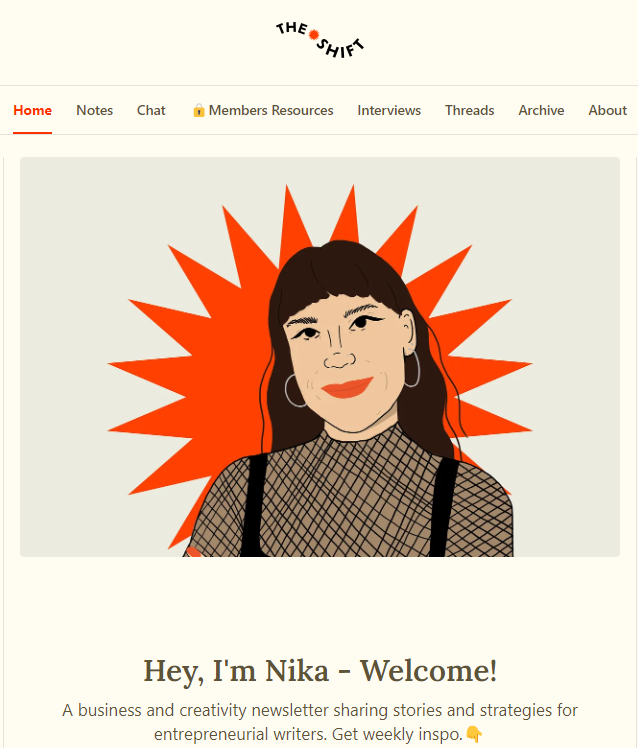
NEWSLETTER IDENTITY CARD
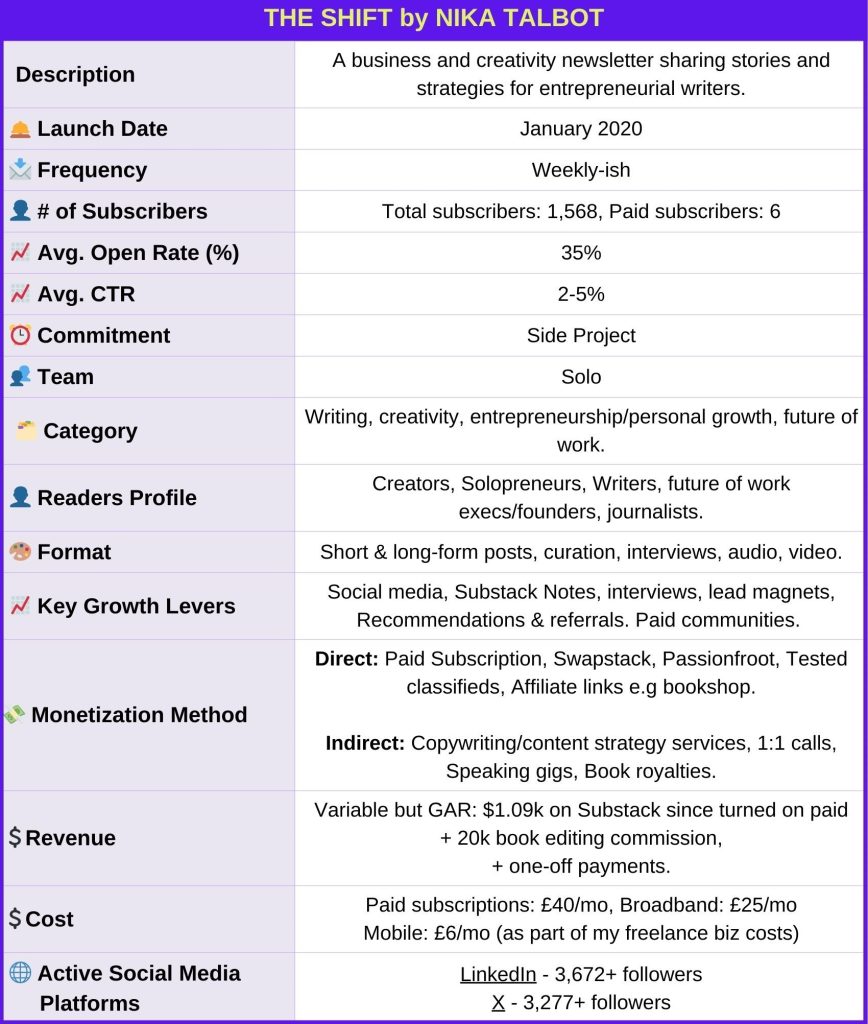
TOOL STACK
- ESP: Substack
- Writing: Google Docs
- Website: WordPress
- Task Management: Google Drive
- Strategy/biz coach: ChatGPT Plus
- Curation & Note taking: Moleskine, Fathom AI notetaker
- Design of visuals: Canva Pro, Getty/iStock
- Growth: Passionfroot, Swapstack, Substack Recs
- Consultancy: Zoom, Calendly
- Digital Products: Amazon, WordPress
- Social Media Tools: Publer
- Affiliate: Amazon bookshop
- Payments: Stripe
- Reader Donation: Ko-Fi
START
Why did you start your newsletter in the first place? What is its role in your professional life?
The Shift was a lockdown project. I started the ‘Corona Diaries’ in March 2020 to document what was happening with Covid and how work was changing.
Freelance work had slowed down and not everyone was getting the same level of financial support. I missed blogging and needed a creative outlet as we couldn’t be let out yet! Substack was just getting going and courting writers & journalists, so I got in there early.
That and Clubhouse kept me sane. I’m entrepreneurial and wanted to build something for myself – a paid community, to be less dependent on corporate budgets and client work. And also, to go deeper on one thing.
TS is a business and creativity newsletter, sharing stories and strategies for entrepreneurial writers. My tagline: “Rethinking work/life in the AI age, and how we can better shape it.” It’s a long-term project that will evolve as I do. I see it as my freedom vehicle 🙂
I’m passionate about helping solopreneurs, especially women, use writing, communication, and AI to grow their businesses. So we can work a bit less and enjoy life more.
GROWTH
How did you gain your first 1,000 subscribers?
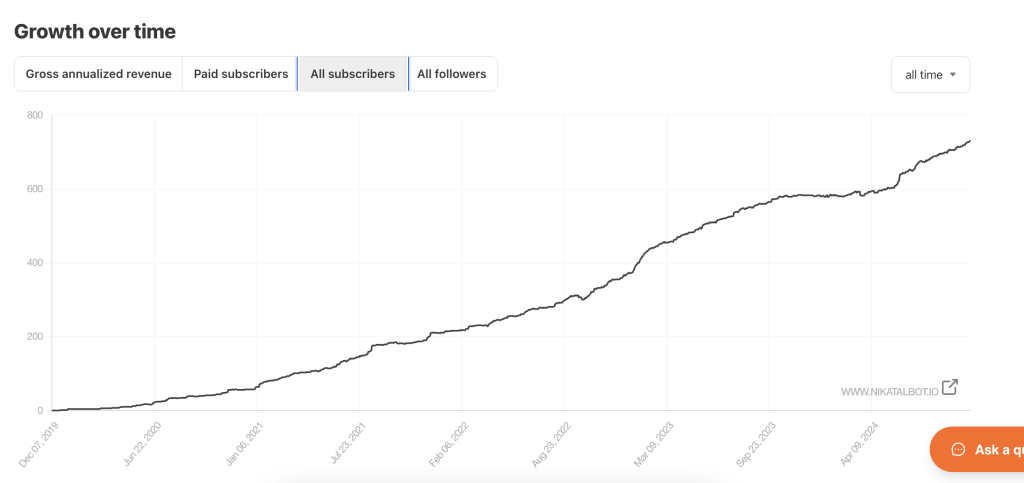
I started from scratch. I didn’t import a list so it’s been slow, organic growth over the last four years.
I focus on writing great content and doing collabs e.g. an interview series, event recaps, plus referrals and recommendations (a powerful tool!). I share excerpts with my network: LinkedIn, Reddit, Notes, WordPress, Medium.
I have one CTA for my newsletter everywhere, and use it as my elevator pitch. I’ve done talks, panels, and training sessions for the National Union of Journalists (NUJ) and The Portfolio Collective. I bore the pants off my sister talking about newsletters! 🤓
“Growth is a lot faster now as we have Notes and Chat as a built-in social network, plus audio, video, and livestreaming – there are so many ways to collaborate.”
It’s fairly easy to grow your free list on Substack – the challenge is converting free to paid.
The conversion rate is 3-5% and can be higher or lower. Not super high by industry standards? Mine’s been mostly free while I’ve been building my list so I’m focusing more on my paid strategy now.
What are the most effective growth strategies you currently use? Can you share a few tips on how you apply those strategies successfully?
My motto: “Let go and let it flow.” No #1 is not obsessing over growth and stats! Otherwise it takes the fun and joy out of it.
“I don’t want to be thinking about it transactionally or get too obsessed with my dashboard stats. I want to show up here excited, with energy and ideas to share, as people can feel that.”
I had to give myself a good talking to about not putting too much pressure on it financially as there are far easier ways to make money online than paid subscriptions. Here are some things I do:
- Share one CTA everywhere: One link that directs folks to sign up and one featured item on LinkedIn (my newsletter).
- Use it as my elevator pitch: “I write the business and creativity newsletter, The Shift – sharing stories and strategies for entrepreneurial writers.” I talk about it as my main gig (even though it’s not financially haha – yet!).
- Join paid communities & masterminds: I wish I’d done this earlier. It is ‘pay-to-win’ in many ways as you need to be in smaller spaces with other folks on the same journey so you can learn from and support each other. Your business is your network!
- Be active on socials: I repurpose/reshare content often and comment on & share others’ work. Yesterday, Maya (Smarter Solopreneurs) posted in her Chat about wanting to grow on LI, and shared a link. This led to a fun chat and a respectful disagreement about solopreneurship vs entrepreneurship as the ‘future of work,’’ which got us both some engagement.
- Do audio voiceovers: They help you grow 2.5x faster on Substack as people feel more connected to you. They also sync with your podcast, which helps you build your library.
- Write great content: Nobody talks about this much, but it’s everything! If the work is quality, people will like/comment/share.
- Read widely and curate good stuff: I think of my NL as a ‘bookshop’ with lots of delightful, surprising things for folks to check out. If you make people feel something, they will pay to be part of it – online shopping can be impulsive (I’m speaking from personal experience here!)
- An interactive welcome email: This is your first touchpoint so make it memorable and keep it short. I offer two free collaborative resources: a WorkFrom (remote work map) and WorkWith (newsletter talent directory). I also ask people to introduce themselves in a thread. I want to know who’s reading.
- I offer free tasters: On my home page so it’s not all behind the paywall. Give people a taste of you, a workshop or a long read, so they can get to know/like/trust you.
- Focus on the audience you have: Ask them what they want & for referrals and recommendations. Most of my client work comes from my existing network so I figure it’s the same for my newsletter. We live in such a culture of more-itis but it’s about building deeper connections.
- Use newsletter directories: I use Lettergrowth, The Sample, InboxReads & my own for promotion and collabs.
MONETIZATION
One of your monetization channel is paid subscriptions. Let’s elaborate on this a bit.
When & how did you decide it was the right time for you to start a paid subscription?
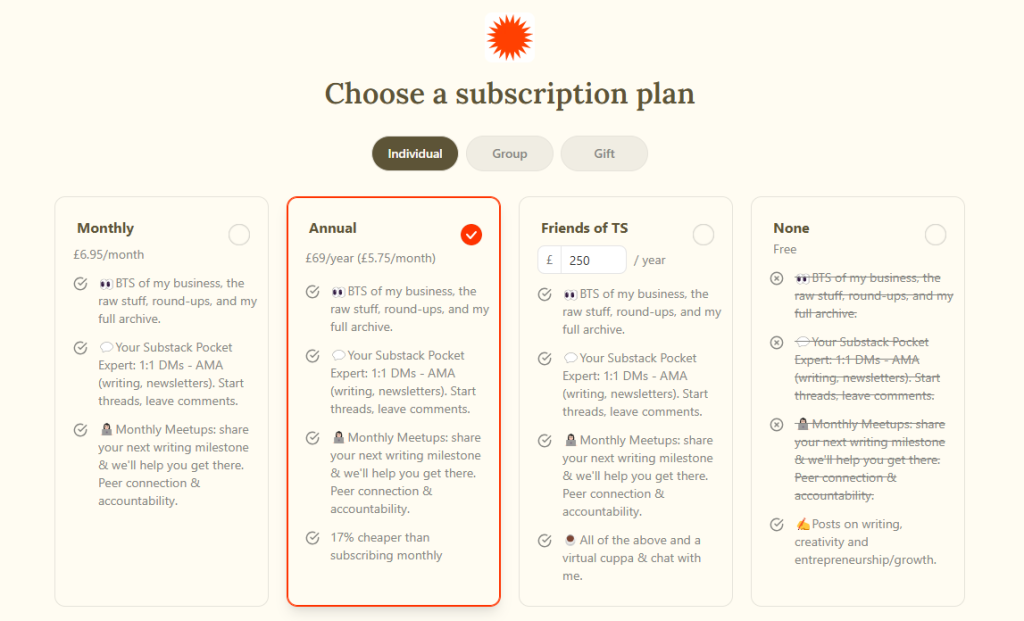
“I was late to the game. It was free for the first 2-3 years while I was figuring things out and building my list. The message we hear is to get to 1k free subs and then turn on paid or 10k subs before you do paid advertising. I disagree.
Turn on paid at the start if you want to build a newsletter business and set that intention. You have to treat it like a business and take it seriously.”
Generosity is one of my values but I realised I wasn’t doing myself justice and valuing my time, energy and experience by giving it all away for free. Just because I don’t like paywalls! You have to nudge people to pay.
I offer a monthly or annual paid membership, a founding tier (Friend of The Shift) and a one-time tip via Ko-fi. It’s important to offer flexibility and one-off payments as there’s a lot of subscription fatigue and people are in so many communities – it can be overwhelming.
I did the Substack Grow programme when it started, which was inspiring and encouraged me to go for it. Just seeing the possibilities and what people were earning = freakin’ awesome! And all on one platform too – a far cry from my blogging days!
How many paid subscribers do you have currently? What are your key strategies to increase that number?
I have six newsletter babies! And I love them all dearly. My goal is to get to 101 paid members, which gives you ‘Bestseller status’ on Substack and brings new opportunities and exposure – e.g. you can join the Product Lab and test new features.
“People don’t necessarily want more content / info but they will pay for access to you, peer connection, inspiration, and accountability. I’m testing how I can offer those things and what’s sustainable for me as a solo creator with clients.”
Here are some things I’m trying:
- I’ve created a ‘Member Resources’ tab on my home page so people can see what I’m offering in one place.

- I offer free content on my home page so people can try before they buy.
- I list the paid perks first on my About page to emphasise the membership benefits. I don’t use the word ‘subscriber’ in my messaging as it feels too transactional.
- I mention paid offerings on socials (bit rubbish at this, need to do it more). I give paying members a shoutout.
- I ask engaged readers to invite a buddy to join – you can offer complimentary subscriptions. I need to get savvy with the coupons!
- Work with a growth whizz: I’m doing group coaching with Lex Roman [Journalists Pay Themselves] to help with the paid side. It’s worth paying someone like Lex, Adriana Tica or Amanda Hinton (all growth whizzes for solopreneurs) as it will save you time, if this isn’t your strength. I’m stronger on the storytelling and editorial side and not that data-driven. Know your strengths and what gives you or drains your energy.
- I joined a mastermind and am in paid communities for peer to peer connection and collabs. This has led to referrals and recs.
- I do paid posts: Testing one monthly paid post (round-ups, writing resources and opportunities). The rest is free, but I add a deep paywall at the end for bonus content e.g. AI guides or video calls.
- I offer 1:1 DMs via chat for paid members. Your Substack Pocket Expert – AMA (about writing, newsletters). It’s a personal, intimate touch as people don’t always like to leave public comments.
What are your biggest learnings when applying for a paid subscription so far?
Work on mindset & boundaries around value, time, experience and charging for my time i.e. paywalling. I’ve tried to let go of the feeling that the work/offering has to be outstanding or super valuable in a biz sense to be worth paying for. It doesn’t, and that’s a lot of pressure to put on myself as a soloist. It can be inspiring, save time, or bring meaning, shared purpose, and a new perspective. In other words, stay light! ✨
Clarity on my paid strategy – set out my stall and write it all down, leading with the paid membership to see how it feels and what’s sustainable. Test things out for at least three months to give it time. People need reminding of what’s on offer. I’ve done reader surveys but it’s more effective to email your members directly and ask why they paid and what they want more/less of.
Less is more. I’ve fallen into the trap of offering too much (I see this all the time on people’s Subscribe pages) and it can feel overwhelming. I don’t have to do all the things e.g. paid workshops just because everyone else is. Simplicity cuts through and we’re craving that in this complex world. Go with your gut!
Repurpose from my day job: I come across a lot of useful resources and opportunities for writers when I’m doing socials for clients so it makes sense to curate these and offer it as a monthly resource for paying members. All of my work feeds into my newsletter, which is a good use of my time rather than feeling like I need to produce more content.
Invest in paid communities: It’s fun, social and you’ll grow faster, together.
Pay attention to my behaviour online. Notice when and why I pay for stuff and use those tactics e.g. I like one-off payments so I offer ‘Buy me a Ko-fi”. I love Dense Discovery as it’s what’s good on the internet, thoughtfully curated – and beautifully designed. I think about how I want to make people feel and the experience I want to create.
Take tiny actions: I promote in some way, every day. ‘Success’ is just a lot of little steps, taken consistently over time. We are our daily habits! Sometimes you just need to get over yourself – no one is paying that close attention.
Know what you want from it: For me, it’s craft, community and collaboration (of course the money is nice too haha, but it’s not my primary driver). Stay focused on your mission or vision.
IMPACT & LEARNINGS
How did building The Shift newsletter contribute to your life professionally and personally?
It’s given me something of my own, which is empowering, grounding and motivating – especially when the money starts coming in.
“Posting weekly gives me structure and focus outside of client work. It’s brought me collabs, connections and paid commissions, including a £20k book editing gig from a founding member – thank you!”
It’s also inspired me to offer a newsletter writing service and niche down so I’m not doing all the things.
I love learning and reading and there’s SO much great writing on the platform to enjoy. It’s made my world bigger – and smaller – at the same time. It’s rewarding to build a paid community of solopreneurs on the same journey who want to grow together.
It’s given me license to be nosy, out in the world, interviewing folks, and trying new things. There are a lot of people betting on Substack, so I’m curious about how the newsletter industry will play out – and following the trends.
It’s a long-term project and is helping me to get clear on my Second Act: more fun, more friends, more freedom! What I want the next chapter of my life to look and feel like.
I think everyone should have a newsletter, even if they’re not selling anything! 😀
What is the most challenging part of operating a newsletter and how do you handle it?
It can be lonely. Writing is often solitary and I work from home mostly. You’re wearing all the hats: writer, creator, strategist, publicist, publisher, editor, community manager, saleswoman, accountant, VA!! Exhausting.
No one person can do all of that well so know your strengths and outsource what you can afford to. I hired an illustrator to do some designs. I try to outsource tiny gigs to support other creatives.
I work from cafes & co-working spaces. I’ve set up collaborative resources. I offer monthly virtual meetups and in-person events too.
The content hamster wheel – posting weekly is high intensity and I don’t plan much content in advance – it can be newsy. Consistency is hammered into us but it doesn’t mean you have to post long-form content at the same time every week.
It can mean you do consistently good work. I’m focusing on collabs e.g. interviews and repurposing old content that’s done well. Also experimenting with formats to keep it fresh: shorter posts, long-form interviews, audio, video, graphics, cross-posting.
A subscription is never-ending! Wrap your head around that. It’s crucial to take holidays and regular breaks as a solo creator. Rather than pausing payments, write out a holiday schedule at the start of the year/quarter so it’s clear when you won’t be publishing. Send a pic from your trip to let your readers know you’re thinking of them. You don’t have to write an essay every week.
Lack of feedback. Sometimes it’s crickets! You might not get a lot of likes or comments and you wonder how things are landing. Let go of the need for the dopamine hit we’ve been conditioned to expect via social media. I often reshare posts and comment on them a bit later. Like all your posts first – be your own biggest cheerleader!
What would you do differently if you had a chance to start over The Shift?
- I would have turned on paid at the start rather than waiting until I’d got to a certain number of readers.
- Fine-tuned my paid strategy. Paywalled more posts.
- Joined paid communities and masterminds sooner and invested in myself e.g. more conferences and events.
- Hired other people to help. Design matters, but it took me years to hire an illustrator.
But the journey, squiggly as it is, has brought me to where I am today! Je ne regrette rien 😘
What would it be if you had the right to give one piece of advice to aspiring newsletter creators?
Don’t get too hung up on your ‘niche’ and fitting into boxes as it will evolve as you do. People want to hear from YOU. Be yourself and bring all of yourself to your work – why do we have to separate life and work? Think about the transformation you want to offer. For me, that’s a struggling writer to AI-assisted solopreneur. AI will make us better humans because it’s giving us more time for ourselves and others 😉
Sorry, there’s more…
- Write fast, edit later. Kill your darlings (especially that intro). Short and sweet!
- Have a full life, do interesting things, be interested in people and life and you’ll bring that energy and spark to it.
- Take time off Substack and socials to avoid comparison-itis and more-itis.
- Don’t worry about trying to sound clever or smart. Don’t be afraid of the mundane – it’s where most of us are, doing the same things daily, and it’s more real and relatable.
- Share your fails as well as your wins – you’ll be far more interesting and useful. As Arnie would say: “Be useful!” 🦾
Final words?
Have fun and be free with it. Making things and connecting with people is a joy.
Less is more. Don’t try to do too much – we’re all overwhelmed with options and choices. Simplicity wins the day!
3 Popular The Shift Issues
- ✍️Game Your Career | #152 – Craft+Work, Conversation Station, and walking London
- ✍️Takeaways from CEX ‘24 | #149 – “The information is dazzling, and the energy will inspire you.
- “Bold Types #11: Lex Roman 🇺🇸- Meet the newsletter writer and subscription marketer helping journalists pay themselves.


